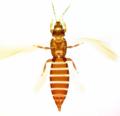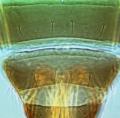Parrellathrips ullmanae
Recognition data
Distinguishing features
Female fully winged. Body, legs and antennae light brown, tarsi yellow also distal half of antennal segment II and base of III; fore wing pale with extreme apex darker. Antennae 9-segmented, distal segments not forming a unit; segments III–IV with incomplete transverse sensorium at apex. Head widened to base; with 3 pairs of ocellar setae, pair III within ocellar triangle; mouth cone extending between fore coxae. Pronotum with about 7 pairs of rather short posteromarginal setae. Metanotum reticulate medially, median setae close to posterior margin; mesopre-episternum separated by distinct suture. Fore wing pointed, first and second veins each with about nine setae. Abdominal tergites with faint transverse sculpture medially, median paired setae on III–VI shorter than distance between their bases; VIII without a marginal comb of microtrichia; X relatively long with partial longitudinal split. Sternites without discal setae, with 3 pairs of marginal setae, on VII the lateral 2 pairs arise on the disc.
Male not known.
Related and similar species
The family Fauriellidae comprises a total of four genera and five species. In addition to this genus and species from California, two genera each with one species are recorded from South Africa, and one genus of two species occurs in southern Europe. There is a wide range of structural variation among these five species, and the phylogenetic significance of the family is thus hard to assess.
Taxonomic data
Current valid name
Parrellathrips ullmanae Mound & Marullo
Original name and synonyms
- Parrellathrips ullmanae Mound & Marullo, 1998: 85
Family placement
Fauriellidae. [Bhatti (2006) has treated this family as a synonym of the family Hemithripidae, although the latter is based on a severely damaged Baltic Amber fossil on which few details can be observed.]
Biological data
Life history
Breeding in flowers.
Host plants
Garrya vealchii (Garryaceae)
Tospoviruses vectored
None
Crop damage
None
Distribution data
Area of origin
Western USA
Distribution
California








